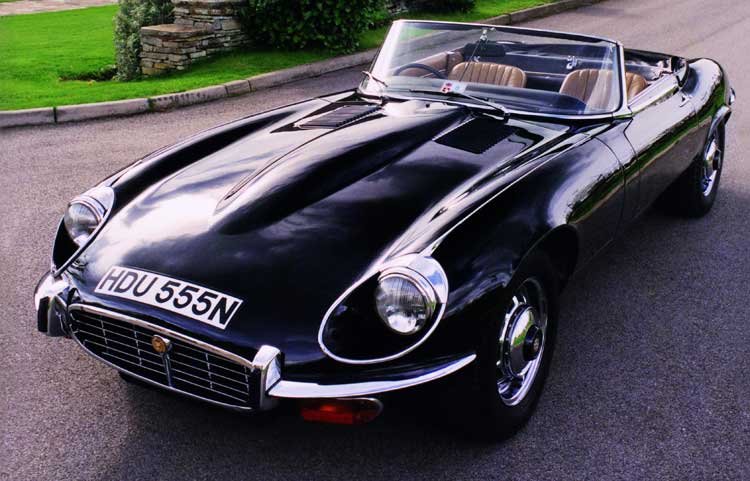Jaguar E-Type
The E-type was the first must-have sports car. Giles Chapman fondly recalls the original babe-magnet

he facts about the Jaguar E-type are etched into every car nut's consciousness: it was derived from a racing car; it was designed by an aerodynamics boffin, not a "stylist"; its stiff chassis and supple suspension gave it a smooth ride and great road-holding.
Normal people, meanwhile, know the E-type as an icon of 1960s freedom - a performance car with a bird-pulling image. "The greatest crumpet-catcher known to man," as US journalist Henry Manney described it.
Trevor Baylis, inventor of the clockwork radio, is one former E-type owner who thrived on the car's macho appeal. "I was Jack-the-lad then," he says. "Sporting around London in a buffalo jacket at the wheel of my E-type. One girl hopped in for a lift and stayed for 18 months. Now I'm into my Viagra years, maybe an E-type would have the same effect."
The E-type was unveiled at the 1961 Geneva Motor Show and became an instant must-have. Its aggressive, dart-like profile, bulging bonnet and tapering tail were like nothing else on the road.
Jaguar's Malcolm Sayer had taken the sleek contours of the D-type that won Le Mans in 1955, 1956 and 1957 and made them work in a road car, while adding necessities such as bumpers and a proper hood. A front number plate would have ruined the looks and aerodynamics, so owners had to put a sticker on the bonnet.
Jaguar knew it had a legend on its hands. The performance was blistering: the 3.8-litre straight-six motor coaxed 149mph out of the roadster; the coupé hit the magic 150mph mark.
Jaguar took 500 orders at the Geneva launch. A month later, in April 1961, the car was at the New York International Auto Show and six sold in the first half-hour. "I want that car and I want it now," barked Frank Sinatra.
And why not? The E-type was a steal. The roadster was £2,097 on-the-road. The Aston Martin DB4 cost £4,084 but could only manage 140mph, while a Ferrari 250GT cost megabucks at £6,469. By contrast, a small family car like the Triumph Herald cost £708, and an average house about £2,700. So if you were on the up, like George Best, George Harrison and James Bond composer John Barry, an E-type was an indulgence your manager would sanction. Owners overlooked the E-type's cranky four-speed gearbox and four-wheel disc brakes that required a he-man shove to work properly.
Jaguar did not rest on its laurels. As boat-loads of E-types set sail for California, where they were sold as the XKE, it set about improving the car. A bigger 4.2-litre engine from 1964 had more torque and came with a vastly improved gearbox, better brakes and comfier seats.
In 1966, a two-plus-two "family" version - and even an automatic option for the ageing lothario - were offered, and the car's raw sporting power began to diminish. But real middle-aged spread set in with the Series II in 1968. The sleek headlight covers were dropped and bigger bumpers fitted on safety grounds, and US pollution laws demanded a less powerful engine. As the mid-sixties Swinging London scene faded, the E-type was getting a slightly embarrassing aura.
A white E-type featured in the corny opening credits of Simon Dee's Dee-Time chat show shortly before the DJ was ejected from our screens, while its status as a disposable used motor was confirmed when two were destroyed in front of a barely-flinching Michael Caine in The Italian Job. People starting lampooning the E-type; maybe my dad's groaningly awful jokes ("What's orange and does 150mph?" "Er, dunno, Dad". "An E-type carrot") echoed nationwide.
The E-type received a welcome image boost in 1971 when Jaguar used the car as a showcase for its first V12, a magnificent engine that turned the E-type into a powerful and unusually silent tourer: a genuine 150mph machine.
But those were anything but ebullient days. In the crisis-gripped Britain of 1974, few people wanted to throw £3,343 at a V12 roadster. Jaguar dealers had real difficulty selling the last 49 examples, a limited edition in jet black paint with a commemorative plaque.
Still, they built 72,007 Jaguar E-types. And that's well over twice the number of all Aston Martins made, ever.
Subscribe to Independent Premium to bookmark this article
Want to bookmark your favourite articles and stories to read or reference later? Start your Independent Premium subscription today.

Join our commenting forum
Join thought-provoking conversations, follow other Independent readers and see their replies